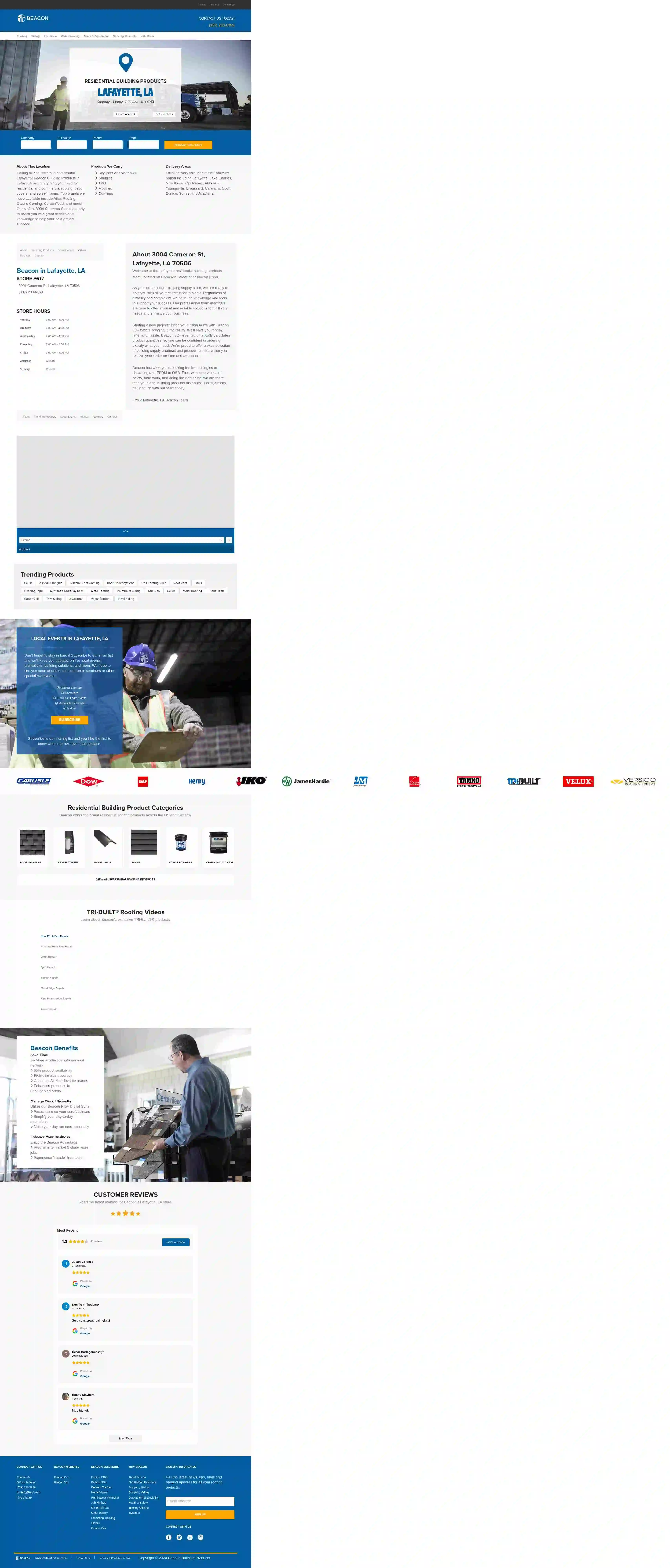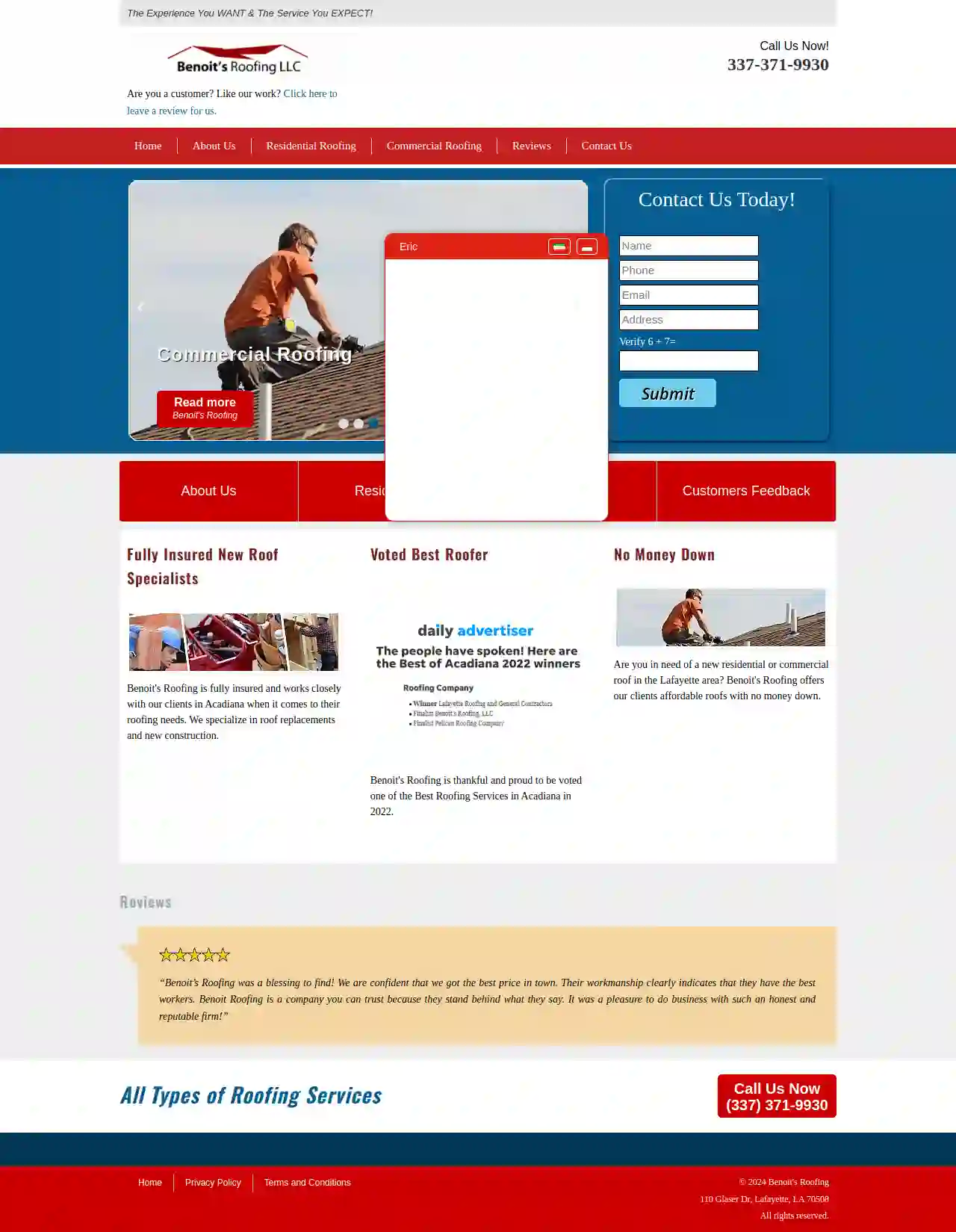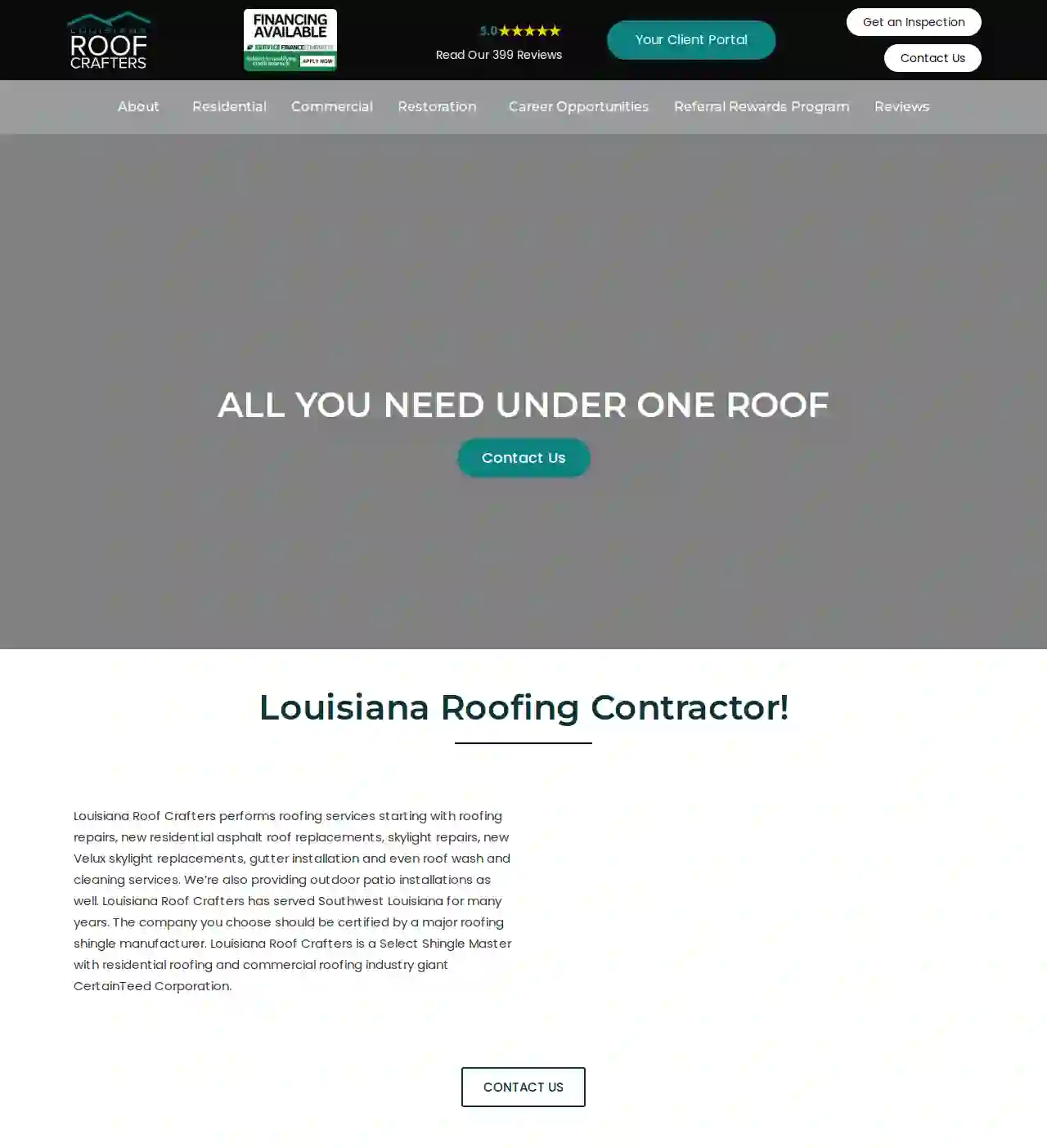Roofing Companies Cheyenne
Find the best Roofing Service in Cheyenne
Get 3 FREE Roofing Services quotes for your project today! Compare profiles, reviews, accreditations, portfolio, etc... and choose the best service.

Bercher Roofing
44 reviews1281 E Magnolia St D #326, Fort Collins, 80524, USBercher Roofing is a family-owned and operated business that provides residential roofing services throughout Colorado from the western slope to the front range and into Wyoming. We have proven time and again that we provide superior roofing services at affordable prices in order to protect your home and investment. As a family-owned and operated business, we will go the extra distance to provide you with the best services and products you need.
- Services
- Why Us?
- Our Team
- Testimonials
- Gallery
Get Quote
Structure Ace Roofing & Solar
4.631 reviews3900 N Causeway Blvd, Ste 1200, 3900 N Causeway Blvd Ste 1200, Metairie, 70002, USStructure Ace Inc. is a global company specializing in disaster relief, green construction, and storm remediation. With a team of experienced engineers and production experts, they offer scalable and efficient system infrastructure solutions. Structure Ace has a proven track record of over 10.8GW of projects completed domestically and internationally. Their team boasts certifications from NABCEP, FSEC/SEI, NCCER, and more, demonstrating their expertise in various fields like solar energy, construction, and energy efficiency. Structure Ace is committed to delivering the next generation of infrastructure that is both resilient and environmentally friendly.
- Services
- Why Us?
- Accreditations
- Gallery
Get Quote
Premier South Roofing & Sheet Metal - New Orleans
Baton Rouge, Louisiana, 9551 Interline Ave, 70809, USWith over ten years in business and a combined experience of decades amongst our staff, you can be confident entrusting your roofing needs to Premier South. We understand that Louisiana roofs are subjected to some pretty extreme circumstances. Exorbitant heat during the summer — and sometimes even a hurricane — can put undue stress on your roof that exacerbates wear and tear. Whether you need residential or commercial roofing services, you can count on our roofers to get the job done efficiently and effectively.
- Services
- Why Us?
- Testimonials
- Gallery
Get Quote
Denver Rapid Roof Repair
Denver, USAs one of America's largest and most respected roofing contractors, we understand how important it is to protect your biggest investments: your business and your home. At ECO Roof and Solar, we install full-service solar power systems for commercial and residential customers. We specialize in providing sustainable roofing solutions for everyone. Our commitment to excellent customer service has given us a national reputation for being honest and reliable. We proudly serve Colorado, Texas, Louisiana, and Florida.
- Services
- Why Us?
- Our Team
- Gallery
Get Quote
Beacon Building Products
4.339 reviews3004 Cameron Street, Lafayette, 70506, USBeacon Building Products in Lafayette has everything you need for residential and commercial roofing, patio covers, and screen rooms. Top brands we have available include Atlas Roofing, Owens Corning, CertainTeed, and more! Our staff at 3004 Cameron Street is ready to assist you with great service and knowledge to help your next project succeed!
- Services
- Why Us?
- Our Team
- Gallery
Get Quote
Benoit's Roofing, LLC
4.638 reviews110 Glaser Dr, Lafayette, 70508, USThe Experience You WANT & The Service You EXPECT! Are you a customer? Like our work? Click here to leave a review for us. Call Us Now! 337-371-9930 Home About Us Residential Roofing Commercial Roofing Reviews Contact Us Job Application HomeAbout UsResidential RoofingCommercial RoofingReviewsContact UsJob Application Previous Next Roof Repair Read more Benoit's Roofing Residential Roofing Read more Benoit's Roofing Commercial Roofing Read more Benoit's Roofing Contact Us Today! Name Phone Email Address About Us Residential Commercial Customers Feedback Fully Insured New Roof Specialists Benoit's Roofing is fully insured and works closely with our clients in Acadiana when it comes to their roofing needs. We specialize in roof replacements and new construction. Voted Best Roofer Benoit's Roofing is thankful and proud to be voted one of the Best Roofing Services in Acadiana in 2022. No Money Down Are you in need of a new residential or commercial roof in the Lafayette area? Benoit's Roofing offers our clients affordable roofs with no money down. Reviews "I recently hired Benoit’s to replace my roof and I am completely satisfied with the job they did. They were able to replace my roof and do cosmetic work on my chimney in a day and a half and their pricing was well below estimates I received from other roofing companies in the area. I would highly recommend them to anyone looking for a roofing company." Eric R. 5 stars "Benoit’s Roofing was a blessing to find! We are confident that we got the best price in town. Their workmanship clearly indicates that they have the best workers. Benoit Roofing is a company you can trust because they stand behind what they say. It was a pleasure to do business with such an honest and reputable firm!" Lisa Puckett 5 stars "I highly recommend Benoit’s Roofing. On time, as promised, good work and on price. The guys on the crew were great, careful and went the extra mile. You need a reference? You can call me if needed. Just call Bristow helicopters in New Iberia and ask for me. Name is published. This company delivers." Robert Old All Types of Roofing Services Call Us Now (337) 371-9930 Home Privacy Policy Terms and Conditions © 2024 Benoit's Roofing 110 Glaser Dr, Lafayette, LA 70508 All rights reserved.
- Services
- Why Us?
- Accreditations
- Testimonials
- Gallery
Get Quote
Louisiana Roof Crafters LLC
4.9119 reviewsLafayette, USLouisiana Roofing Contractor is your trusted partner for all your roofing needs. With over 399 satisfied customers, we have a proven track record of delivering exceptional quality and service. Our team of experienced professionals is dedicated to providing you with the highest level of expertise and craftsmanship. We offer a comprehensive range of roofing services, including roof repair, roof installation, new roof construction, and rain gutter installation. Whether you need a minor repair or a complete roof replacement, we have the skills and resources to get the job done right. At Louisiana Roofing Contractor, we understand that your roof is a vital investment in your home or business. That's why we use only the highest quality materials and employ the latest roofing techniques to ensure long-lasting durability and protection. We are fully licensed and insured, giving you peace of mind knowing that you are in good hands. Contact us today for a free estimate and experience the Louisiana Roofing Contractor difference.
- Services
- Why Us?
- Gallery
Get Quote
The Roof Sharks
51 reviewsUSThe Roof Sharks is a family-owned and operated roofing and siding company based in Battle Creek. They are CertainTeed Select Installers and specialize in asphalt and metal roofing. The company has over 25 years of experience and is dedicated to providing top-quality products and services at affordable prices. Their team of skilled technicians is committed to working with customers to find the perfect roofing and siding solutions for their needs and budget. The Roof Sharks offers a variety of services, including free consultations, financing options, and a satisfaction guarantee.
- Services
- Why Us?
- Gallery
Get Quote
Garcia Roofing
4.7179 reviewsLafayette, USSince 1992, Garcia Roofing has been a name associated with quality and trustworthiness across Baton Rouge, New Orleans, Lafayette, Covington, and the entire Northshore. From the decking to gorgeous metal accents—Garcia handles the entire roofing process with precision and expertise. Whatever your roofing needs may be, you can trust Garcia to get the job done right! We want all our customers to happily say, “GARCIA DID MY ROOF!™”
- Services
- Why Us?
- Accreditations
- Our Team
- Testimonials
- Gallery
Get Quote
Schroeder Roofing & Gutters
4.17 reviewsLoveland, USSchroeder Roofing is a team of roofing contractors who have superior knowledge and experience in asphalt, shingles, tile, flat roofing, metal, synthetic slate, shakes, and more. Whether you need a new roof for your home or your business, whether it's a large project or a simple roof repair, Schroeder Roofing of Loveland will assess your roof's condition and let you know what you need to keep you protected. We’re proud to provide honest, effective roofing services, and are happy to help homes and businesses across Northern Colorado. Browse our site to find the services you need, and feel free to contact us today for your project quote!
- Services
- Why Us?
- Our Team
- Testimonials
- Gallery
Get Quote
Over 17,196+ Roofing Companies on our directory
Our roofing contractors operate in Cheyenne and beyond!
Roofyng.com has curated and vetted Top Roofers arround Cheyenne. Find the most reliable pro today.
Frequently Asked Questions About Roofing Companies
- Experience: Companies with a solid track record and years of experience in the industry.
- Licensing and Insurance: Verify they are properly licensed to operate in your area and carry adequate insurance to protect you from liability.
- Certifications: Look for certifications from reputable organizations, demonstrating expertise in specific roofing materials or techniques.
- Positive Reviews: Check online reviews and testimonials from previous customers.
- Professionalism: Choose a company that communicates clearly, provides detailed estimates, and has a courteous and responsive team.
- Asphalt Shingles: Popular, affordable, available in various styles (3-tab, architectural, etc.)
- Metal Roofing: Durable, long-lasting, energy-efficient, available in panels, shingles, or tiles.
- Tile Roofing: Clay, concrete, or slate; known for longevity, durability, and aesthetic appeal.
- Flat Roofing: EPDM rubber, TPO, PVC, modified bitumen, or built-up roofing (BUR).
- Slate: Natural stone, extremely durable, expensive, requires expert installation.
- Wood Shakes or Shingles: Natural wood, aesthetically pleasing, requires regular maintenance.
What is the difference between a roof overlay and a roof tear-off?
Roof Overlay: Installing a new layer of roofing material over the existing roof. It's less expensive and faster, but not always ideal.
Roof Tear-Off: Completely removing the existing roofing before installing a new one. More labor-intensive but allows for inspection and repairs to the roof deck.
A tear-off is typically preferred, but a roofing contractor can advise on the best approach for your situation.
What is the difference between a roofer and a general contractor?
Roofer: Specializes in roof installations, repairs, and replacements. They have expertise in roofing materials, techniques, and safety practices specific to roofing.
General Contractor: Oversees and manages entire construction projects, including hiring and coordinating subcontractors, such as roofers, electricians, plumbers, etc. They handle overall project planning, scheduling, and budgeting.
For roofing projects, it's generally best to hire a roofing contractor who specializes in roof work.
How do I find a good roofing company?
What are the different types of roofing materials?
What is the difference between a roof overlay and a roof tear-off?
Roof Overlay: Installing a new layer of roofing material over the existing roof. It's less expensive and faster, but not always ideal.
Roof Tear-Off: Completely removing the existing roofing before installing a new one. More labor-intensive but allows for inspection and repairs to the roof deck.
A tear-off is typically preferred, but a roofing contractor can advise on the best approach for your situation.
What is the difference between a roofer and a general contractor?
Roofer: Specializes in roof installations, repairs, and replacements. They have expertise in roofing materials, techniques, and safety practices specific to roofing.
General Contractor: Oversees and manages entire construction projects, including hiring and coordinating subcontractors, such as roofers, electricians, plumbers, etc. They handle overall project planning, scheduling, and budgeting.
For roofing projects, it's generally best to hire a roofing contractor who specializes in roof work.
How do I find a good roofing company?
- Experience: Companies with a solid track record and years of experience in the industry.
- Licensing and Insurance: Verify they are properly licensed to operate in your area and carry adequate insurance to protect you from liability.
- Certifications: Look for certifications from reputable organizations, demonstrating expertise in specific roofing materials or techniques.
- Positive Reviews: Check online reviews and testimonials from previous customers.
- Professionalism: Choose a company that communicates clearly, provides detailed estimates, and has a courteous and responsive team.
What are the different types of roofing materials?
- Asphalt Shingles: Popular, affordable, available in various styles (3-tab, architectural, etc.)
- Metal Roofing: Durable, long-lasting, energy-efficient, available in panels, shingles, or tiles.
- Tile Roofing: Clay, concrete, or slate; known for longevity, durability, and aesthetic appeal.
- Flat Roofing: EPDM rubber, TPO, PVC, modified bitumen, or built-up roofing (BUR).
- Slate: Natural stone, extremely durable, expensive, requires expert installation.
- Wood Shakes or Shingles: Natural wood, aesthetically pleasing, requires regular maintenance.